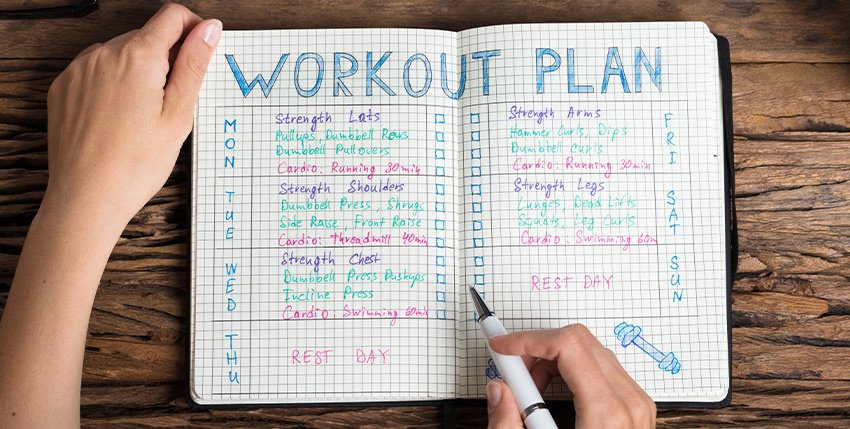We all know the routine by now. The holidays come. We overindulge, which leads to holiday weight gain. And then when our favorite pair of jeans feels a bit too snug, we decide that we’ll exercise more, eat healthier, and take better care of our body and mind… in the New Year.
In fact, research shows that 95% of New Year’s resolutions are fitness related – exercising more and losing weight. However, after just three months, only 10% of people think their resolution will last, and approximately 80% of people who make New Year’s resolutions drop them by the second week of February.
So, if you’re someone who wants to stop this vicious cycle once and for all, the good news is that it’s possible as long as you have a good habit-forming plan in place and are willing to do the work.
Elements To Making A Habit Stick
The psychology behind habit formation is what helps us create good new habits and also what helps us break bad old habits. That’s because every habit starts with a psychological pattern called a ‘habit loop.’
The habit loop is made up of three main components that work together for habit formation. First, there’s a cue, or trigger, that tells your brain to go into automatic mode and let a behavior unfold. Basically, anything around you – a person, a feeling, a scent – that reminds you of the habit, or makes you want to put it in action, is the cue.
Next, there’s the routine, which is the behavior itself. This is typically what we think about when we think about habits. And since habits aren’t just one action that’s disconnected from the rest of your actions, what comes before and after the habitual behavior is also part of the habit.
The reward is the third and final step in the habit loop process. It’s something that your brain likes, or considers to be a positive outcome, that helps it remember the habit loop in the future in order to achieve the satisfaction of the reward.
Why Is Exercise Such A Difficult Habit To Form?
Since exercise is a complex behavior that requires effort, it’s not as easy to develop as other simple habits like brushing your teeth. New research finds that it takes more than a conditioned cue (or trigger) such as an alarm clock to stick with an exercise routine because if exercise is not a habit for you, that cue from your alarm may trigger a debate over whether to exercise or go back to sleep. And we all know how that’s going to play out, especially since a survey found that it takes Americans an average of 24 minutes to get out of bed and start their day – after two alarms and hitting snooze twice, of course.
The new research determined that it’s the combination of a cue such as a morning alarm, plus an intrinsic reward (performing a task because it’s personally rewarding to you) that helps develop and maintain exercise as a habit. Therefore, the research suggests that if exercise is intrinsically rewarding – it’s enjoyable or reduces stress – that people will respond automatically to their cue and not have to convince themselves to work out.
On the other hand, if you’re exercising to lose weight or for other extrinsic reasons (completing a task or exhibiting a behavior because of outside causes such as avoiding punishment), you’ll still have to make a decision when you encounter your cue or trigger. So, to make exercise a habit, it’s important to be intrinsically motivated. This way instead of working out feeling like a chore that you’d rather avoid doing at all costs, you’ll actually want to exercise when you encounter your cue or trigger.
So, now that you’re aware of the way that both good habits and bad habits (or habits to avoid) form, as well as the type of motivation that can help you create healthy habits, you can start doing the work to achieve your desired outcome – making exercise a habit.
8 Strategies That Make It Easier To Stick With An Exercise Habit
Lab studies have shown that it’s never too late to break a bad habit. In fact, habits are actually malleable throughout your life. Therefore, you can 100% make exercise a daily habit, especially now that you’re aware of the habit loop and understand the crucial role of both the cue and the reward. So, let’s take a closer look at eight strategies that make it easier to stick with an exercise habit.
1. Commit To Working Out For A Full Month
People often think that it takes 21 days to form a new habit, but one study found that it takes anywhere from 18 days to 254 days to build a new habit. So, while there’s technically no magic number when it comes to building a new healthy habit, the key to developing good habits is repetition. Therefore, exercising for four weeks straight, especially while you have high motivation, will likely lead to a healthy behavior change that will also last in the long run.
2. Piece Your Workout Together
We get it, going from zero to a full month of exercise can be overwhelming, especially if your time is limited. However, instead of telling yourself that you need to block out 30 minutes for exercise, five days a week, what if you reframe your thinking and commit to exercising for 10 minutes in the morning, 10 minutes in the afternoon, and 10 minutes at night? Wouldn’t that be a lot less intimidating and a whole lot more achievable?
And maybe best of all, piecing your workout together can still give you much of the same benefit as exercising for 30 minutes all at once. So, if you find that you’re having trouble staying on track with the exercise schedule that you created for yourself, try piecing your workouts together instead.
3. Combine Your Exercise Session With Something That You Crave
By combining something that you crave with something that’s healthy, you’ll want to do that healthy thing. So, if one of your guilty pleasures is watching reality TV, use that to your advantage. Instead of watching reality TV on your couch, watch it at the gym while running on the treadmill or exercising on the elliptical. You can also do easy exercises at home like bodyweight squats and lunges while watching reality TV, the big game, or whatever it is that you crave!
4. Choose A Physical Activity (Or Workout Routine) That You Actually Like To Do
Instead of grinding through a workout routine that you hate, wouldn’t it be better if you actually looked forward to exercising? So, if you’re someone who doesn’t like to run, but you love to swim – go swimming instead of running! It’s that simple.
Or if you’re looking to beat gym boredom, change things up a bit and try some new classes. Spin classes, kickboxing, and yoga are all great ways to keep things fresh and exciting. And if you’re more of a dancer, then take a dance class, or even just go out dancing with your friends. In fact, dancing on your feet for 50 minutes to an hour while moving to the beat can burn up to 450 calories.
5. Exercise With A Partner
Not only can working out with a friend, family member, or co-worker make exercising more fun, but a workout buddy can also offer support and encouragement. Think about it, if you schedule an exercise session with a friend, won’t you be more likely to show up for it? Exactly!
And since the people you surround yourself with have a major impact on your habits, make sure to choose a workout partner who will encourage you when you’re losing motivation and hope. As a general rule of thumb, try to spend time with people whose habits you want to adopt, as well.
6. Listen To Your Body
At some point in your life, you probably heard the phrase, ‘No pain, no gain!’ Well, that’s complete BS! While a little soreness is normal after you first start exercising, pain is not! So, listen to your body and take a break from exercising if you’re experiencing pain.
That said, a good way to deal with soreness (not pain!) from working out is through active recovery. So, after your workout session, make sure to spend five to 10 minutes cooling down doing an active recovery activity such as walking on a treadmill or cycling at low-intensity. You can also do active recovery activities such as walking, swimming, or yoga between exercise days.
7. Reward Yourself
Now that we know how important the reward is in the habit loop process, go ahead and reward yourself after you accomplish the short-term and long-term goals that you set for yourself.
For example, if you’re a runner and your goal was to run three times a week every day for a month and you do just that, then go ahead and treat yourself to something special like a snazzy new pair of running shoes, or maybe even a massage to relax your hard working muscles. After all, you deserve it, and the reward will also help keep you motivated!
8. Don’t Get Discouraged
We’d all love to see incredible gains after just a few exercise sessions, but it can take weeks or even months sometimes to notice some of the benefits of exercise like more strength, stamina, energy, or weight loss. And since we know that it takes some people longer than others to develop a new healthy habit, cut yourself some slack if it doesn’t become a habit in only 21 days. It’s actually supposed to take longer than that! So, don’t get discouraged. Just keep showing up and doing the best that you can each and every day!
*The links used in this article are being provided as a convenience and for informational purposes only; they do not constitute an endorsement or an approval by Iovate Health Sciences International Inc. or any of its affiliates (“Iovate”) of any of the products, services or opinions of the corporation or organization or individual. Iovate bears no responsibility for the accuracy, legality or content of the external site or for that of subsequent links. Contact the external site for answers to questions regarding its content.







